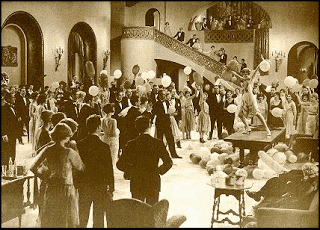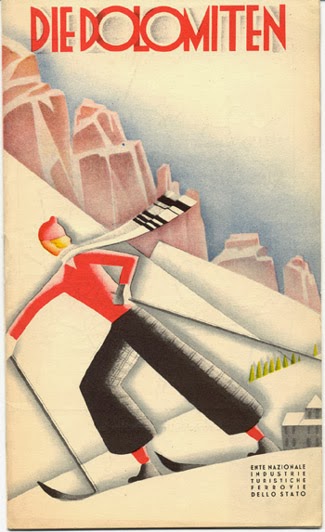I chose to research an era which I find particularly interesting so that I can explore it with a more in depth approach, and so chose the 1920s. The elements that I have previously been interested in during this era have been the fashion and the social aspects of the decade. I have a huge appreciation for the very close attention to detail in all aspects of this but would like to look further into the bigger picture.
I chose to focus on a few significant elements or aspects to 'The Roaring Twenties':
Art Deco
Objects and buildings that seem everyday started to be embellished with all sorts of patterns like zigzags and chevrons, all mostly angular. Vehicles, trains, and other means of transport started to look much more futuristic, which worked with the emerging popularity of travelling, which had been made very glamourous by magazines like Vogue. Steel, glass and wood were used to make things like furniture and buildings appear more sleek and modern, and with the economy booming, the world was able to afford expansive use of expensive materials.
Walt Disney and Steamboat Willie
Amongst the sudden great changes in American theatre and cinema, was Disney's first sound cartoon 'Steamboat Willie', which then became legendary, as the first public debut of Mickey and Minnie Mouse, two of the worlds most recognised cartoon characters worldwide. Remembering the film years later, Disney said:
"The effect on our little audience was nothing less than electric. They responded almost instinctively to this union of sound and motion. I thought they were kidding me. So they put me in the audience and ran the action again. It was terrible, but it was wonderful! And it was something new!"
Charlie Chaplin
Amongst some of the most popular films of the decade were the comedies of Charlie Chaplin, born in 1889 on April 16th in London. His career started when he joined the Eight Lancashire Lads, eventually leading him to parts in Sherlock Holmes and Casey's Court Circus, but initially started to become recognisable after the part of the Tramp in 'The Kid' in the early 1920s.
The Foxtrot
The Foxtrot was developed in the United States in the 1920’s. Named after its inventor, entertainer Harry Fox, the Foxtrot is often associated with the smooth dancing style of Fred Astaire and Ginger Rogers. It has become one of the most popular ballroom dances in history.
The Foxtrot is very similar to the Waltz. Both are extremely smooth dances that travel along a line of dance counterclockwise around the floor. The rise and fall action of the Foxtrot comes from the long walking movements made by the dancers. The dance combines quick steps with slow steps, giving dancers more flexibility in movement and greater dancing pleasure. The Foxtrot is typically danced to big band swing-style music, but may be danced to most music types.
Ballroom Tango
American style tango’s evolutionary path is derived from Argentina to U.S., when it was popularised by silent film star Rudolph Valentino in 1921, who demonstrated a highly stylised form of Argentine tango in The Four Horsemen of the Apocalypse. As a result, the Hollywood style steps mixed in with other social dance steps of the times began this branch away from the Argentine style. Meanwhile, the tango was also making its own inroads into Europe.
Following the English standardisation of their version of Tango, Arthur Murray, a ballroom dance instructor in the U.S., tried his own hand at standardising the ballroom dances for instruction in his chain of social dance schools. This looser social style was referred to as American style by the English.
The Jazz Scene
Throughout the 1920s, music became an integral part of popular culture in the US, particularly jazz, as it was a genre that appealed to people from a variety of societies and social backgrounds. It had a profound effect on the literary world through jazz poetry, and a huge influence on the fashion of the 1920s.
Jazz music also aided the elevation of the status of African Americans as it was a distinctly African American genre of music.
Flappers
Flappers were a "new breed" of young Western women in the 1920s who wore short skirts, bobbed their hair, listened to jazz, and flaunted their disdain for what was then considered acceptable behaviour. Flappers were seen as brash for wearing excessive makeup, drinking, treating sex in a casual manner, smoking, driving automobiles, and otherwise flouting social and sexual norms. Flappers had their origins in the liberal period of the Roaring Twenties, the social, political turbulence and increased transatlantic cultural exchange that followed the end of World War I, as well as the export of American jazz culture to Europe.
In addition to their irreverent behaviour, flappers were known for their style, which largely emerged as a result of French fashions, especially those pioneered by Coco Chanel, the effect on dress of the rapid spread of American jazz, and the popularisation of dancing that accompanied it. Called garçonne in French ("boy" with a feminine suffix), flapper style made girls look young and boyish: short hair, flattened breasts, and straight waists accentuated it.
Speakeasy's
Speakeasies were hidden sections of an establishment that were used to illegally sell alcohol during the Prohibition. Similar to some of today's clubs, there was singing, dancing and performances. People involved with speakeasies mainly revolved around gangs, who supplied the liquor, namely in particular Al Capone and his gang. The people who went to the speakeasies (or "blind pigs") went to get alcohol after the Prohibition came into effect. Speakeasies often featured jazz bands and plenty of flappers dancing.
These covered up wild parties, the illegal transportation of liquor and the skyrocketing rate of gang activities, made the 1920s a very secretive and rebellious era.
The Travel Poster
To grab the attention of the people, advertisers created posters to market a variety of products and services.
Art Deco travel prints were by far the most popular advertising materials of the day.
Images of young, fashionable urbanites in exotic locales appeared everywhere.
Also, travel transportation was heavily marketed - especially that of trains, ocean liners, planes and automobiles.
Graphic Design
The invention of the printing press in the 1920s made it easy to mass produce books, newspapers, magazines and other literature.
Of course, if you were going to run a newspaper or a magazine, you needed advertisers.
This huge demand for advertising dollars led to massive developments in the realm of Art Deco Graphic Design. Advertising agencies sprung up everywhere producing a variety of advertising media -posters, travel brochures, postcards, invitations etc..
They all had the classic Art Deco look - streamlined, geometric. To complement the imagery, a new font, was created which was more angular and straight than its cursive predecessor, Art Nouveau.
Furthermore, as beauty and the 'decorative aesthetic' became increasingly important in all aspects of design, this style shift also affected Graphic Design.
Where in the past, utility and functionality were enough, now beauty and style could not be ignored either.
Product packaging, book jackets, billboards, building signs and other common objects had to reflect beauty, as well as functionality.
The sentiment of the day was that "the street was the art gallery for the public" (Aynsley, 2003) and nowhere is this sentiment most obviously expressed, as in the area ofGraphic Design.










































No comments:
Post a Comment